![]()
Methadone
Useful medicine or addictive opiate?
![]()
Henry Goss-Custard
Eton College
![]()
Molecule of the Month April 2023
Also available: HTML version.
![]()
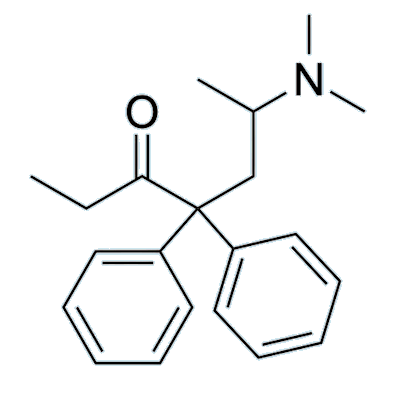
Methadone
MethadoneUseful medicine or addictive opiate?
Henry Goss-Custard
Molecule of the Month April 2023
|
 Methadone |
Have you ever met or read about someone with an opiate addiction? Or someone who overdosed on drugs? It’s tragic for them and can be extremely tough on those around them. There are so many people, from all sorts of backgrounds and different socio-economic groups who have overdosed on drugs at one time or another.
Well, there are some famous opiate users below.
 |
 |
 |
| Prince - died of a fentanyl overdose in 2016. [Photo: Penna, via Wikimedia Commons] |
Jim Morrison- thought to have died of a heroin overdose in Paris in 1971. [Photo: Elektra Records, via Wikimedia Commons] |
Carrie Fisher - died in 2016 with heroin in her bloodstream [Photo: Riccardo Ghilardi, via Wikimedia Commons] |
Can addiction be cured?Unfortunately there is no easy ‘cure’ for addiction: it is a complex problem with no straightforward solutions. However, there are therapies and medications available to help those who are ready to try to leave their addiction behind. These include methadone, buprenorphine, naltrexone and disulfiram to name a few. The topic for today is methadone. So what is Methadone?Methadone is a synthetic opioid. In other words, it’s a type of opioid that has been artificially created in a lab, rather than being derived from the opium poppy or morphine. It was invented in 1937 by German scientists Max Bockmuhl and Gustav Ehrhart whose aim was to create an opioid which could be readily manufactured using widely-available industrial precursors. It was borne of an opiate shortage crisis in Germany where, owing to war shortages and a sudden rise in the consumption of opiates, Germany was running seriously low on stocks. It was hoped that methadone would also have less addictive potential while offering similar pain relief to traditional opiates. However, not long after methadone was brought to market in Germany, it was swiftly abandoned as a painkiller as a result of adverse side-effects, such as vomiting, that were encountered among its early users. |
 A cup of methadone [Photo: DEA.gov] |
 Opium poppy [Photo: By YubKook via Wikimedia Commons] |
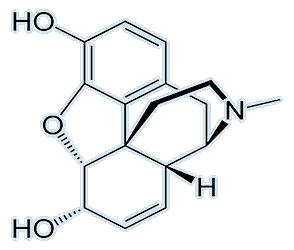 Morphine [Image: Benjah-bmm27, via Wikimedia Commons] |
Ironically, although it was invented to be a painkiller, it is nowadays seldom used for pain-killing applications (for reasons elaborated later), but as is often the case, it found application elsewhere…
In the following years, its uses varied, ranging from an antitussive (cough medicine) to suppressing drug cravings and managing addiction.
After the war, the Allies took possession of many German patents and research documents as compensation, including their work on methadone. American scientists noted that despite still having some addictive potential, methadone produced less euphoria, sedation, and respiratory depression than morphine, and so still had potential as a useful painkiller. In the 1960s, American researcher Vincent Dole investigated its potential as a substitution therapy for withdrawal from illicit opiates such as heroin (see MOTM for March 2023). At that time, New York City was experiencing a heroin epidemic which was giving rise to a significant surge in deaths arising from heroin misuse, and campaigners had begun advocating for the establishment of clinics offering treatments that might help tackle the crisis.
In short, the reason it is not commonly used as a first-line pain medication is because the body is slower to metabolise it than natural opiates. This means it has a longer ‘half-life’ (analogous to radioactive half-life, describing the time it takes for the body to eliminate 50% of the compound in the body). As a result of this, methadone can more easily accumulate in the body, which increases the risk of overdose and, ironically, addiction too.
Our brains contain millions of opioid receptors, which evolved as part of our bodies’ natural pain management and pleasure-reward systems. Technically speaking, methadone is known as an ‘agonist at opioid receptors’. What this means is that it activates the brain’s opioid receptors in a similar way to the body's self-made opiates. The brain’s opioid receptors are similarly activated by other administered opiates, such as morphine (MOTM for November 2004) and heroin (MOTM for March 2023).
However, with an optimal dose, methadone can reduce cravings for other opioids and prevent withdrawal symptoms from other more addictive opiates. In effect, methadone takes up the limited sites where any opioid can bind - we will elaborate on this later. It also works as an antagonist on NMDA glutamate receptors. This receptor is important for the induction and maintenance of sensation of central pain states. Methadone acts as a blockade of the flow of information to and from this receptor and the brain and thus contributes to pain suppressing symptoms.

The brain responds to opioids through three receptors: the μ (mu), δ (delta), and κ (kappa) receptors. The mu-receptor is the primary receptor to which most opioids bind, particularly those that induce euphoric effects. While drugs such as heroin and methadone do exhibit some binding affinity to the other opioid receptors, their effects on the delta and kappa receptors are generally thought to be secondary to their primary effects on the mu-opioid receptor. Methadone and other opioid-substitution-treatment drugs (OST drugs) have a very strong binding affinity to the mu-opioid receptor, and one which is higher than that of other opioids.
Doctors treating opiate addiction will sometimes induce what is known as a ‘methadone reservoir’ where methadone, which unlike natural opiates is a fat-soluble drug, is stored in the fatty tissues of the body creating what is, in a sense, a slowly administering supply of methadone. This is useful because it means that if other opiates are consumed thereafter, they will have a limited euphoric effect. This is especially helpful for those addicted to substances like heroin: studies show that with a correctly-judged level of methadone administered, it is very difficult for an individual to override its effects by virtue of it having this stronger affinity for the mu-opioid receptor. So with sufficient levels of methadone in their bloodstream, the methadone molecules occupy opioid-receptor binding sites making it extremely difficult for other opioids to displace the OST drug once it has attached itself. The phenomenon is known as the ‘blockade effect’ and is one of the reasons behind methadone's suppression of drug cravings. The effect is particularly powerful in extreme cases of opiate dependency and addiction.
The opioids that are commonly used recreationally tend to tarnish the reputation of the ‘opioid family’. However, it's important to note that our body produces many natural opioids that play a crucial role in regulating and managing our reward system, pain perception, and other physiological functions.
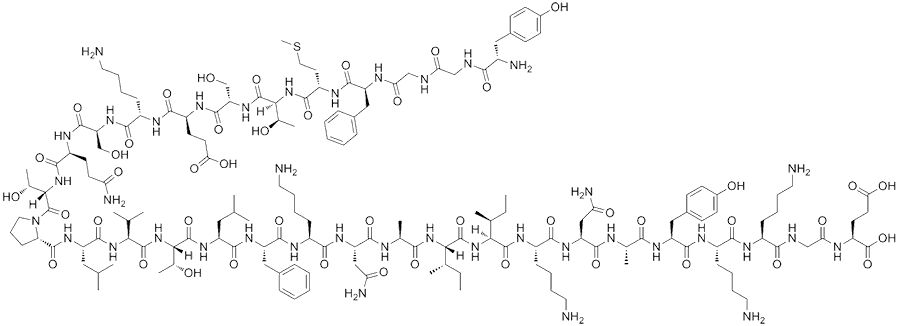 Beta Endorphin - high affinity for opioid receptors. [Image: Edgar181 via Wikimedia Commons] |
You will have likely heard of something called an endorphin. If you’ve ever gone for a long run or done a substantial bit of exercise, you may find yourself feeling more upbeat, or ‘high’ in the subsequent few hours. This is a result of the endorphins released by the body, whose purpose is to reduce or block the perception of pain (say, to allow you to continue running without giving up as a result of the pain). They also have the effect of increasing your feeling of wellbeing. Endorphins are endogenous opioids naturally produced by the body, and humans have around 20 different types of endorphins which work at different times and fulfil different functions, each one being crucial for separate reasons. Of course we don’t have opioid receptors in our brains simply for the sake of recreational drug use! They play an extremely important role in the body and the way they operate and interact is complex. Okay, back to methadone: how is it metabolised?One interesting property of methadone is that the human body metabolises it very slowly (with a 24-to-48 hour half-life) which is much slower than any other opiate. This explains why it has such a long duration of action. |
 If you really want more opioids in your system, then go for a run! [Photo: Martin Addison via Wikimedia Commons] |
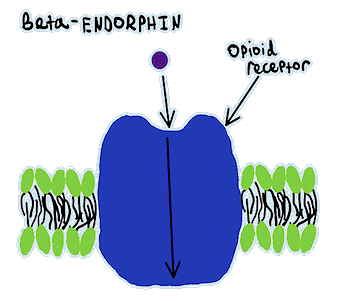 It’s also very lipophilic, meaning it is highly soluble in fats and most oils: it can be stored in fatty tissues of the body for a much longer period of time than, say, morphine. As a result, the methadone is slowly released and metabolised giving it a more ‘gentle’ effect over a long period of time, rather than inducing the intense highs typically caused by illicit opioids.
It’s also very lipophilic, meaning it is highly soluble in fats and most oils: it can be stored in fatty tissues of the body for a much longer period of time than, say, morphine. As a result, the methadone is slowly released and metabolised giving it a more ‘gentle’ effect over a long period of time, rather than inducing the intense highs typically caused by illicit opioids.
Methadone is mostly metabolised in the liver where it undergoes a process called N-demethylation and is broken down into its metabolites (the name for the substances produced when a larger molecule is broken down). While numerous studies have been conducted to learn more about the metabolism of methadone, there is still some uncertainty about exactly how it occurs. However, we do know that it is chiefly broken down by cytochrome P450 enzymes into 2-ethylidene-1,5-dimethyl-3,3-diphenylpyrrolidine (this is EDDP, an inactive metabolite) in the liver, with CYP3A4 and CYP2B6 being major contributors. N-demethylation is the process where a methyl group is removed. In this case, the enzyme CYP3A4 strips the methyl group from its nitrogen atom. It is a pretty important step because the remaining structure of methadone (EDDP) is less pharmacologically active and is more easily removed in the urine.
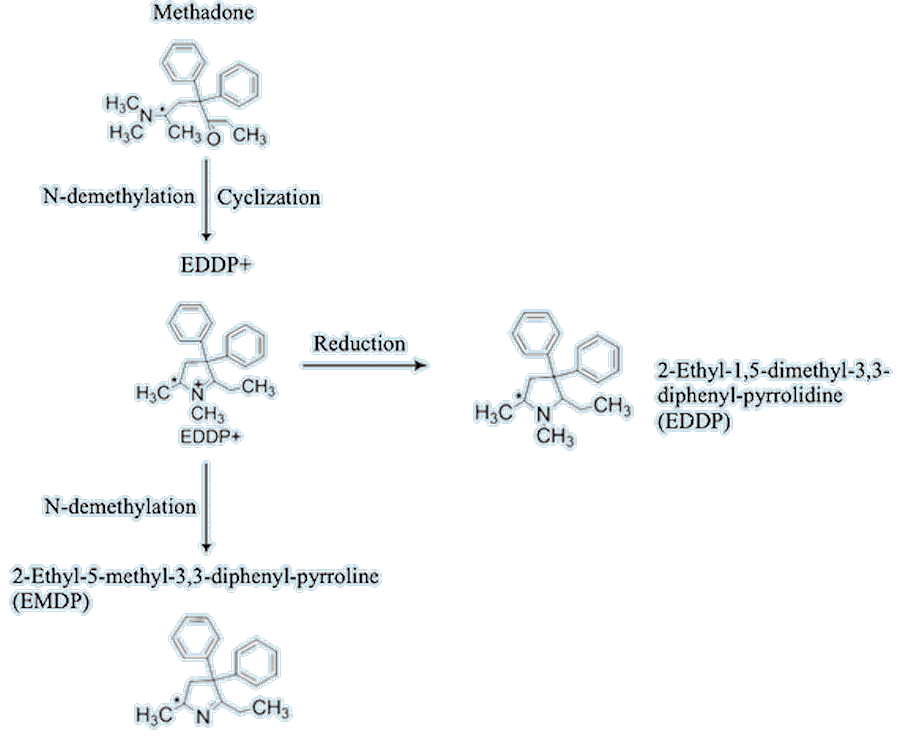
The process of synthesising methadone is a long and complex one. It can be manufactured in several different ways and, as with many other drugs, the methods of production are often evolving, with scientists exploring and discovering different ways of producing it.

The process begins with 2,2,-diphenylacetonitrile reacting with 3-chloro-1-dimethylamino propane. These are reacted in a condensation reaction (releasing HCl as a by-product) to form an intermediate compound. This compound then is reacted with a Grignard reagent (in this case C2H5MgBr) followed by sodium hydroxide to form methadone. The reason behind the Grignard reagent’s use is to form new carbon-carbon bonds, which you can see between oxygen and carbon, above.
I’ve heard it’s been given to prisoners?Yes, methadone rehabilitation treatment is offered to prisoners who have opioid usage disorder. There have been studies conducted to investigate the likelihood of reoffence and continued drug use after release, many of which have returned somewhat positive results. In one study, it was seen that Methadone Maintenance Treatment (MMT) significantly increased patient compliance and lowered overdose risk for at least 12 months following release. In a group of 179 opioid addicts at the Rhode Island prison, an impressive 23% ceased heroin usage in the following month, after having been treated with MMT. "Methado or Methadon’t"?It may seem on the surface rather odd to contemplate the treatment of opiate addiction by simply substituting it with another opiate. There is much controversy in the media surrounding this topic as many feel that the addiction is merely replaced and not resolved. There are cases where addicts simply divert their cravings to methadone - and if so, what has been achieved? In fact, methadone itself is now responsible for one-third of deaths resulting from opioid drugs in the U.S and some say that withdrawal from methadone is even harder than heroin itself. Since methadone is taken as a part of a long-term treatment plan, patients become accustomed to maintaining consistent levels of methadone in their bloodstream, which gives rise to many problems in of itself. Methadone has almost certainly done a lot of good in its time but is equally not the silver bullet that its advocates had once hoped. |
 The singer Amy Winehouse was known for drug and alcohol abuse. The song 'Rehab' was about her refusal to go to rehabilitation treatment. |
![]()
![]()
![]() Back to Molecule of the Month page. [DOI:10.6084/m9.figshare.22300711]
Back to Molecule of the Month page. [DOI:10.6084/m9.figshare.22300711]